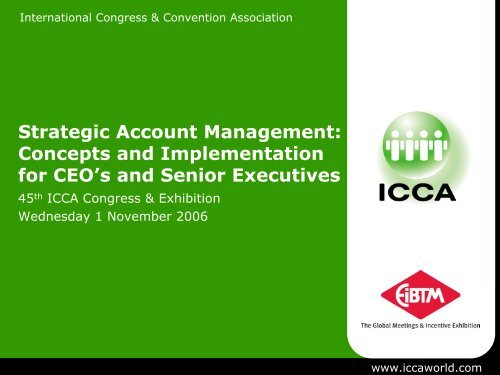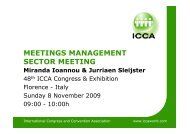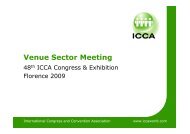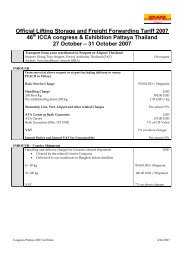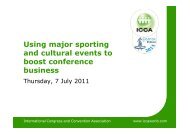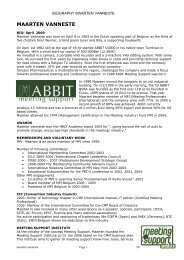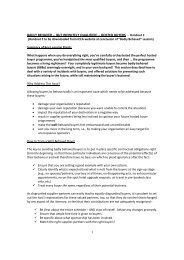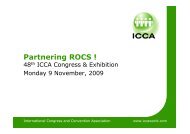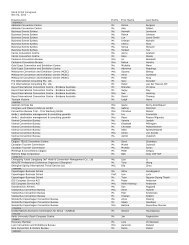Strategic Account Management: Concepts and ... - ICCA
Strategic Account Management: Concepts and ... - ICCA
Strategic Account Management: Concepts and ... - ICCA
Create successful ePaper yourself
Turn your PDF publications into a flip-book with our unique Google optimized e-Paper software.
International Congress & Convention Association<br />
<strong>Strategic</strong> <strong>Account</strong> <strong>Management</strong>:<br />
<strong>Concepts</strong> <strong>and</strong> Implementation<br />
for CEO’s <strong>and</strong> Senior Executives<br />
45 th <strong>ICCA</strong> Congress & Exhibition<br />
Wednesday 1 November 2006<br />
www.iccaworld.com
<strong>ICCA</strong><br />
<strong>Strategic</strong> <strong>Account</strong> <strong>Management</strong><br />
<strong>Concepts</strong> <strong>and</strong> Implementation Issues<br />
for CEOs <strong>and</strong> Senior Executives<br />
Leadership Synergies, LLC<br />
John S. Parke, President <strong>and</strong> CEO<br />
410-414-9920<br />
www.leadershipsynergies.com<br />
2
Today’s Agenda<br />
Segment 1: Session Overview<br />
Segment 2: Client Needs Assessment<br />
Segment 3: <strong>Account</strong> Action Plan<br />
Segment 4: Session Summary<br />
3
What Is SAM?<br />
A business strategy focused on a small number of<br />
important clients, viewed as a corporate assets with<br />
significant long-term value<br />
Find ways to help both parties make <strong>and</strong> save money<br />
The voice of the customer within your company<br />
4
The Basics of SAM<br />
Select the right accounts<br />
Define the value proposition<br />
Conduct needs assessments<br />
Create account action plans<br />
Present findings to the client (verify the plan)<br />
Deploy cross-functional teams<br />
Implement the plans<br />
Summarize results for senior leadership to make longterm<br />
strategic decisions<br />
Help both parties find ways to make <strong>and</strong> save money<br />
5
Key <strong>Account</strong> Selling as Part of SAM<br />
re-<strong>Account</strong> <strong>Management</strong> Selling:<br />
One-to-one contact<br />
Supplier presentations focus on their own issues <strong>and</strong> concerns<br />
Response to customer inquiries is “yes” or “no” based on<br />
assumed customer needs <strong>and</strong> supplier capabilities<br />
The seller seeks volume potential<br />
The customer seeks evidence of competence <strong>and</strong><br />
competitiveness<br />
The customer will judge competitiveness based on price<br />
The customer may require a trial period<br />
The buyer may act as “gatekeeper” <strong>and</strong> prevent access to other<br />
buyers<br />
rtions adapted from International Business <strong>and</strong> Economics Prograamme, Lulea University of Technology, David Mattgard & John Astrom<br />
6
Key <strong>Account</strong> Selling as Part of SAM<br />
arly-Stage <strong>Account</strong> <strong>Management</strong>:<br />
Principal contact is between two people—buyer <strong>and</strong><br />
seller<br />
The relationship may be competitive—each seeking<br />
advantage<br />
Price discussions dominate—buyer focuses on cost<br />
Customer is still assessing alternative suppliers<br />
ortions adapted from International Business <strong>and</strong> Economics Prograamme, Lulea University of Technology, David<br />
Mattgard & John Astrom<br />
7
Key <strong>Account</strong> Selling as Part of SAM<br />
id-Stage <strong>Account</strong> <strong>Management</strong>:<br />
Principal contacts start to facilitate other contacts<br />
through mutual trust<br />
Increased time spent in meetings<br />
Increased trust <strong>and</strong> openness<br />
Mishaps can occur, causing setbacks<br />
This is a lot of work for both buyer <strong>and</strong> seller<br />
ortions adapted from International Business <strong>and</strong> Economics Prograamme, Lulea University of Technology, David<br />
Mattgard & John Astrom<br />
8
Key <strong>Account</strong> Selling as Part of SAM<br />
artnership Stage:<br />
Information is shared<br />
Relationship is based on trust<br />
Access to people is facilitated<br />
Clear vendor ratings <strong>and</strong> performance measures are in place<br />
Value is sought through integrated business practices<br />
Value is sought through focus on customer’s needs<br />
rtions adapted from International Business <strong>and</strong> Economics Prograamme, Lulea University of Technology, David Mattgard & John Astrom<br />
9
Synergistic Stage<br />
ynergistic Stage (SAM):<br />
Joint R&D<br />
Transparent cost <strong>and</strong> margins<br />
Focus on innovation (Blue Ocean thinking)<br />
Joint business plans<br />
Collaborative approach to customers’ new markets <strong>and</strong> end<br />
users<br />
Shared communications<br />
Shared training<br />
Both parties find ways to make <strong>and</strong> save money<br />
ortions adapted from International Business <strong>and</strong> Economics Prograamme, Lulea University of Technology, David Mattgard & John Astrom<br />
10
The Needs Assessment<br />
: What is it?<br />
A: A survey guide you use to interview your clients.<br />
: How do I use it?<br />
A: One-on-one with your clients—you ask questions <strong>and</strong> documen<br />
the answers.<br />
: How long does it take?<br />
A: About 45 minutes per interview.<br />
: How often will I use it?<br />
A: With all your best accounts, it will be ongoing.<br />
11
Needs Assessment Q & A (continued)<br />
: What will happen with the results?<br />
A: They will be collected <strong>and</strong> summarized, then used for<br />
strategic planning.<br />
: What’s the “win” for me in doing this work?<br />
A: There are several: improved customer relationships,<br />
better closure rates = $$, increased customer loyalty,<br />
well-defined voice of the customer.<br />
12
Client Needs Assessments<br />
"Do you use a formal needs assessment process?"<br />
78%<br />
22%<br />
Yes<br />
No<br />
• How many organizations<br />
use a client needs<br />
assessment?<br />
13
Needs Assessment<br />
Client interview questions<br />
<strong>Strategic</strong>:<br />
What changes have occurred in your industry<br />
during the last 2 years?<br />
How have these changes impacted your<br />
organization?<br />
What changes are forecasted for your<br />
organization during the next year?<br />
What are the top three priorities for your<br />
department in the next year?<br />
14
Needs Assessment<br />
What are your top four priorities when you research a<br />
destination for your meeting/event?<br />
What are your meeting/event objectives or goals?<br />
Please tell me about your attendees – their profile,<br />
needs, <strong>and</strong> expectations.<br />
Do you find it easy to work with _____?<br />
1 2 3 4 5 NA<br />
Does ______ identify <strong>and</strong> resolve problems effectively?<br />
1 2 3 4 5 NA<br />
Does ______ provide responsive customer service?<br />
1 2 3 4 5 NA<br />
15
Using Customer Data to Make<br />
Long-Term Decisions<br />
Organizational strategy<br />
Planning<br />
Competitive assessment<br />
New products <strong>and</strong><br />
services<br />
Deployment<br />
16
Creating an <strong>Account</strong> Strategy<br />
<strong>and</strong> Plan<br />
• Analyze your<br />
position<br />
• Consider<br />
alternatives<br />
• Create action plan<br />
• Implement<br />
17
Automatic Red Flags<br />
• Missing critical information<br />
• Uncertain about<br />
information<br />
• Un-contacted buyers<br />
• Buyer is new to position<br />
• Reorganization<br />
18
Perception Is Reality<br />
Response is determined<br />
by the buyer’s<br />
perception of:<br />
– Immediate business<br />
situation<br />
– How proposal will change<br />
that situation<br />
– Whether or not that change<br />
will make the needed impact<br />
Adapted from The New <strong>Strategic</strong> Selling by Stephen E. Heiman <strong>and</strong> Diane Sanchez with Tad Teluja. Miller-Heiman, Inc., 1998.<br />
19
Assessing the Conditions:<br />
Response Modes<br />
Customer’s<br />
Desired<br />
State<br />
DISCREPANCY<br />
RESULT<br />
Is there a<br />
difference?<br />
REALITY<br />
Customer’s<br />
Current<br />
State<br />
What Is the Impact of Your Proposal?<br />
Adapted from The New <strong>Strategic</strong> Selling by Stephen E. Heiman <strong>and</strong> Diane Sanchez with Tad Teluja. Miller-Heiman, Inc., 1998.<br />
20
Condition: Growth Mode<br />
• Vitals:<br />
– Perceives discrepancy<br />
– Receptive to change<br />
– Change to improve a good<br />
situation<br />
• Probability of action:<br />
– High<br />
• Trigger words:<br />
– More, better, faster,<br />
improved<br />
• Clutch:<br />
– Your proposal must be the<br />
change that will reduce or<br />
eliminate the discrepancy<br />
DISCREPANCY<br />
RESULT<br />
REALITY<br />
21
Condition: Trouble Mode<br />
• Vitals:<br />
– Perceives discrepancy<br />
– Receptive to change<br />
– Change to fix a bad<br />
situation<br />
• Probability of action:<br />
– High<br />
• Trigger:<br />
– Help! Sense of urgency<br />
• Clutch:<br />
– Proposal must be the<br />
change that will quickly<br />
reduce or eliminate the<br />
discrepancy<br />
DISCREPANCY<br />
RESULT<br />
REALITY<br />
22
Condition: Neutral Mode<br />
• Vitals:<br />
– Perceives no discrepancy<br />
– Not receptive to change<br />
– Nothing to fix<br />
• Probability of action:<br />
– Medium; Red Flag<br />
• Triggers:<br />
– “Don’t rock the boat”<br />
• Clutch:<br />
– Proposal is a threat unless<br />
another buyer pressures or<br />
you can demonstrate<br />
discrepancy<br />
RESULT<br />
REALITY<br />
23
Condition: Reverse Mode<br />
• Vitals:<br />
– Doing better than<br />
anticipated<br />
– Not receptive to change<br />
– Nothing to fix<br />
• Probability of action:<br />
– Low; Red Flag<br />
• Triggers:<br />
– “Never been better”<br />
• Clutch:<br />
– Proposal has a negative<br />
impact on reality<br />
REALITY<br />
RESULT<br />
24
Underst<strong>and</strong>ing Potential<br />
Outcomes<br />
I WIN<br />
YOU WIN<br />
I WIN<br />
YOU LOSE<br />
I LOSE<br />
YOU WIN<br />
I LOSE<br />
YOU LOSE<br />
Adapted from The New <strong>Strategic</strong> Selling by Stephen E. Heiman <strong>and</strong> Diane Sanchez with Tad Teluja. Miller-Heiman, Inc., 1998.<br />
25
Identify <strong>and</strong> Underst<strong>and</strong> Buying<br />
Influences: Buyer Types<br />
• Who is involved in the decisionmaking<br />
process for this sale?<br />
• Roles, not titles<br />
Economic Buyer<br />
User Buyer<br />
Technical Buyer<br />
Coach Buyer<br />
Source: The New <strong>Strategic</strong> Selling<br />
26
The Players: Economic Buyer<br />
• Position: Rubber stamp<br />
• Role: Give final approval to buy<br />
– Controls money<br />
– Veto power<br />
• Focus: Bottom line <strong>and</strong> organizational impact<br />
• Asks:<br />
– What is the ROI?<br />
– How will this impact our organization?<br />
27
The Players: User Buyer<br />
• Position: Tester<br />
• Role: Judge impact of product/service on his/her<br />
job performance<br />
– Will use or supervise use of product/service<br />
– Link between User Buyer’s success <strong>and</strong> the<br />
success of product/service<br />
• Focus: Task at h<strong>and</strong><br />
• Asks:<br />
– How will this work for me in my<br />
job/department?<br />
28
The Players: Technical Buyer<br />
• Position: Gatekeeper<br />
• Role: Measure quantifiable aspects of<br />
product/service against specifications<br />
– Can’t give final approval<br />
– Can advise against based on technicalities<br />
• Criteria: Price, delivery schedule,<br />
logistics, terms <strong>and</strong> conditions, credit,<br />
regulations<br />
• Focus: Not win, but play<br />
• Asks:<br />
– Does this meet requirements?<br />
29
The Players: Coach Buyer<br />
• Position: Yoda<br />
• Role: Act as guide for sale<br />
– Provide/interpret information about<br />
validity of single sales objective,<br />
other buyers, plan<br />
• Focus: Your success with this objective<br />
• Asks:<br />
– How can we ensure that this solution<br />
is accepted?<br />
30
Questions <strong>and</strong> Answers<br />
Next steps<br />
Research materials<br />
www.SAMA.org<br />
31
International Congress & Convention Association<br />
Thank you!<br />
45 th <strong>ICCA</strong> Congress & Exhibition<br />
Wednesday 1 November 2006<br />
www.iccaworld.com


